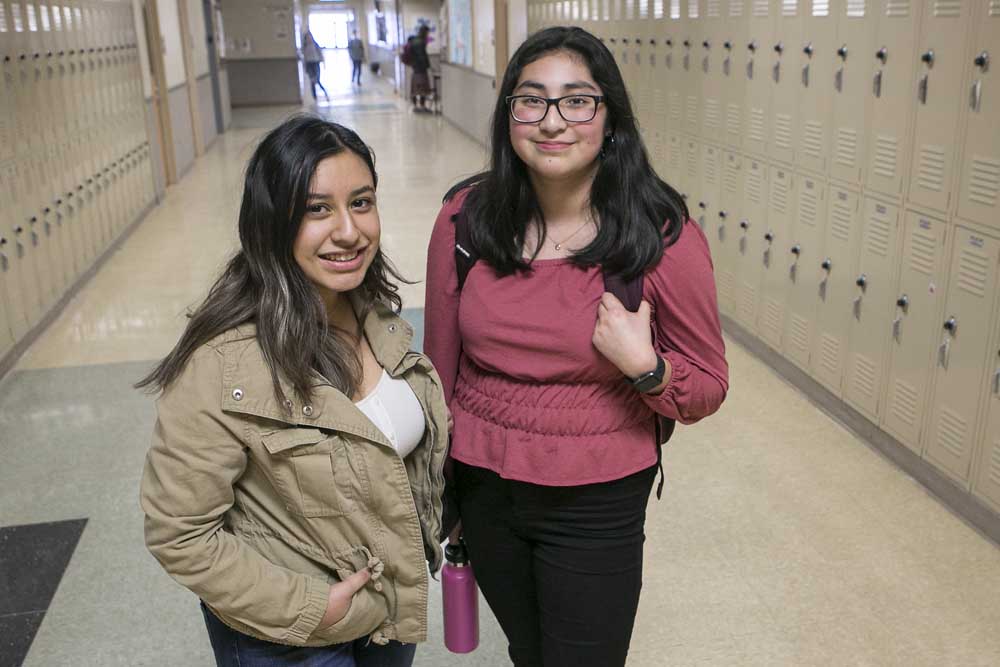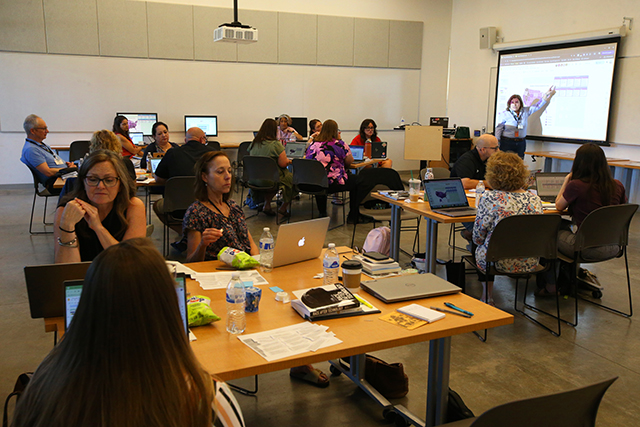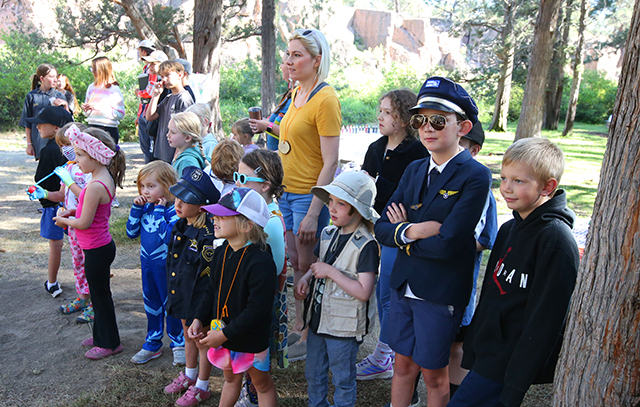Summit, Mountain View high schools have big graduation rate gap between Latino, white students
Published 5:00 am Sunday, February 16, 2020

- Students Andrea Cuenca, 16, left, and Lindsey Ramirez, 16, stand together at Summit High School on Wednesday, Feb. 5, 2020.
Andrea Cuenca and Lindsey Ramirez are both 16 years old and in their junior year at Summit High School. The two students are from Spanish-speaking Latino households, and they both live in Deschutes River Woods.
Here’s another thing Andrea and Lindsey have in common: They both say Summit High School — statistically the whitest large high school in Oregon last year — is a tough place to be a Latino student.
Trending
“You feel out of place,” Lindsey said. “It definitely does have an impact on how you’re going to do, since you’re expected to do worse, since you don’t automatically fit in.”
“We’re the outsiders,” Andrea agreed.
This sense of isolation is one of many potential reasons why some Latino students struggled to graduate at Summit and Mountain View high schools in 2019. Both Bend schools had a wide gap in graduation rates between white and Latino students that year, particularly when compared to neighboring Bend High School.
Students, school district leaders and local Latino advocates say some Latino students are struggling at these two schools because of a general feeling of isolation and disrespect, a lack of teachers and staff who are also Latino and the difficulty of overcoming a language barrier.
The principals at both Mountain View and Summit high schools said they were working to close the graduation rate gap between Latino and white students at their schools.
“We’re aware of it ; we’re concerned about it,” said Michael Hicks, principal of Mountain View High School. “I know that we’re trying a multi-point of attack to close that gap.”
Trending
“We all know that (graduation rates) are important, and we want to find ways to improve it, and we think that starts from the moment they walk into the school,” said Michael McDonald, principal of Summit High School.
The stats
For the class of 2019, 88.2% of Mountain View High School’s white students earned a diploma, compared to 74.4% of its Latino students. The gap was even more pronounced at Summit High School, where 91.9% of white students graduated in 2019, compared to 72.7% of Latino students.
At both high schools, Latino students had a lower 2019 graduation rate than the Oregon average for Latino students, which is 76.2%.
Bend High School had a significantly higher graduation rate for its Latino students compared to the other two high schools in Bend, and the state, at 86.2%.
Not earning a high school diploma can make it extremely difficult for students to attend college, and Latinos without a college degree, like most Americans, make less money. Latinos with a bachelor’s degree or more had a median annual earning of $57,000 in 2016, compared to $35,000 for Latinos as a whole, according to a Georgetown University study.
Bend and Mountain View high schools have similar-sized Latino student populations, making up 16% and 14% of the schools’ respective student bodies in the 2018-19 school year.
The student body at Summit High School, comparatively, is much whiter: Less than 7% of its students identified as Latino in 2018-19. Among Oregon high schools with at least 750 students, it had the highest percentage of white students that year and third-smallest percentage of Latino students, according to state data.
About 23% of Oregon students statewide identified as Latino, according to the state.
Isolation, disrespect and stereotypes
Both Andrea and Lindsey said they’re successful academically. But Andrea added that there’s a persistent stereotype of Latino students not doing well in school.
Because of that, she’s seen some of her peers at Summit High School buy into that stereotype and stop giving effort in their classes.
“My friends get discouraged,” Andrea said. “They’re like, ‘Oh, I’m not going to graduate, I know that,’ so they don’t care at this point. They’re like, ‘It’s okay if I get a D.’”
Some of Andrea’s classmates have also teased her and her Latino friends for their ethnicity, and even used racial slurs, she said.
Although Lindsey felt that Summit High School has a safe environment, her white classmates are almost always uncomfortable discussing race, she said. This can make students of color feel excluded, she said.
“Most kids that are white, that’s not a topic that they talk about,” Lindsey said. “But if you’re ethnic, that’s what you mostly talk about.”
Lindsey and Andrea’s experiences are consistent with what anonymous families and students told Bend-La Pine Schools in a large survey this fall. Not only did students of color, including Latino students, tell the district that racial jokes and slurs were consistently directed at them, but they also were concerned these incidents weren’t being taken seriously by school staff.
“Last year two kids were being racist during Spanish class and teacher didn’t say anything,” an anonymous student said in the survey. “Pretty sure she heard it. It wasn’t whispered.”
Oscar Gonzalez is a staff member at the Bend nonprofit group Latino Community Association who works with local Latino students. He said one way Latino students and other students of color could feel more welcomed is to have history textbooks with more diverse and less Anglicized viewpoints.
“The curriculum needs to become more culturally responsive, so our kids, and other kids, get the full story,” Gonzalez said.
Lack of Latino staff
Teachers who are people of color help students of color perform better in school, according to the California-based education nonprofit Learning Policy Institute.
Gonzalez agreed wholeheartedly, adding that local schools also need more Latino counselors, administrators and other school staff members.
“Not that Anglos or African Americans or people from different backgrounds can’t work with our kids, because of course they can,” he said. “But (students) need diversity, because it’s a diverse world.”
But Bend-La Pine Schools’ teaching staff doesn’t reflect the diversity of its students, according to state data. Out of the three Bend high schools, Mountain View High School has the most Latino teachers: 7% of its teachers identify as Latino, compared to 14% of its students. At Summit and Bend High, 3% and 2% of teachers identify as Latino, respectively.
Andrea and Lindsey said they can’t remember having a Latino teacher, or any person of color as a teacher, during their many years as students in west Bend schools.
Suzie Heydon, one of Mountain View High School’s assistant principals, said when she led survey groups for the school district this fall, she consistently heard a need for more staff of color.
“More than one student said they wanted to see people who looked like them in their classrooms and hallways,” Heydon, who identifies as Latina, said. “I hope … that students feel that I’m approachable, as well as any of my staff can be approached with any concerns and questions.”
The language barrier
Many Latino families in the area speak Spanish at home. Having parents who don’t speak very much English can make it difficult to connect to English-dominant school systems like Bend-La Pine.
Heydon, who is bilingual, said she often takes calls from and meets with Mountain View High School’s Spanish-speaking parents and guardians, and they’re usually happy to know someone can communicate.
“I feel that there’s an immediate sense of relief on some of their faces, when I speak to them in Spanish,” she said. “Some of them reported to me that prior to a conversation that I had with them, they didn’t feel comfortable walking into their school.”
Ruth Jones runs the Juntos program in Central Oregon, which helps local Latino students succeed in high school and get into higher education institutions. The program’s after-school meetings are entirely in Spanish, which provides a more welcoming environment for many Latino families, compared to a typical parent or college/career night led by English speakers.
“You’re not going to understand if you don’t have people that look like us, have shared experiences, and speak the language,” Jones said. “It’s not only intimidating for the families that come in, but it’s also intimidating for the secretaries that don’t speak our language — it goes both ways.”
Andrea and Lindsey said their families only speak Spanish at home. Lindsey joked that her mother will stop her if she starts to talk in English.
Because they were raised to speak one language at home, and taught in a different one at school, the Summit High School students said school can still be difficult. Even though it’s been years since Andrea or Lindsey has attended an English as a second language class, most assignments require additional effort, as they translate everything from English to Spanish and back again in their heads.
“It’s just a lot of extra work you have to put in,” Lindsey said.
The two students added that they’re not alone with this challenge, as their Latino friends often find themselves struggling with the language barrier as well.
“There is this one friend, especially, who has to ask me, ‘Do you know what this means,’ because we have to translate it,” Andrea said.
Andrea and Lindsey still have a year and a half to go before graduating high school. They said they’re working very hard to combat the negative stereotypes about Latino students and make their families proud.
“You’re at the point where you’re like, ‘I need to defy this, I need to do better, and I need to get the best grades I possibly can,’” Lindsey said.
“I try not to get into (the negative stereotypes), because I know I can do better,” Andrea said, tearing up. “I will do better for my family.”
In 2019, Latino students at Mountain View and Summit high schools graduated at lower rates than the statewide average or at neighboring Bend High School. But there are still a variety of solutions that can help these students, according to local Latino advocates and educators.
One of these solutions already exists: Juntos. The Oregon State University-backed program hosts after-school Spanish-language meetings for families for six to seven weeks, helping Latino families better understand the American school system and getting students connected to higher education opportunities, according to Ruth Jones, who runs the program locally.
The program has been successful in boosting the confidence of Latino families and students in their own educational potential, Jones said. She pointed out that at Bend High School and Ridgeview High School in Redmond, two schools with robust, highly-attended Juntos programs, Latino graduation rates are much higher than the state average and very close to white students’ graduation rates.
“(People say,) ‘We can’t afford for our kids to go to (college),'” Jones said. “What if we were to remove that lie … and bring them proof, bring them people from universities that can explain that they can do it.”
Mountain View High School has a well-attended Juntos program, but Juntos hasn’t been to Summit High School in a couple years, partly due to a lack of Spanish-speaking volunteers in that area, Jones said.
But the program is returning to Summit High School this spring. This excites Michael McDonald, the school’s principal.
“That is a key program for us,” he said. “The families feel welcome, and we in the school learn a lot along the way.”
Strong relationships, both with fellow students and school staff, can also help Latino students succeed, said Oscar Gonzalez from the Latino Community Association. He noted that one way to do this is through multicultural clubs — something all three of Bend’s major high schools have.
“If a student feels good about where they are, and where their place is in the school community, of course they’re going to have better academic outcomes,” Gonzalez said.
Lindsey Ramirez, a junior at Summit High School, said she’s the co-president of her school’s muticultural club. It’s a welcoming place for Summit’s students of color, she said.
“We talk about racism, and it’s a safe place for students from all around to come and talk about their experience in the Bend-La Pine school system,” Lindsey said.
Having greater access to after-school programs and extracurricular activities could also help reduce Latino students’ feelings of loneliness, according to multiple educators and Latino community leaders. When Andrea Cuenca, the junior at Summit High School, attended Pine Ridge Elementary School, she always wanted to attend the after-school choir, but it didn’t fit with her mother’s busy work schedule.
Liz Vargas is one of four Latino student liaisons in Bend-La Pine Schools. She provides support for Latino students at Summit High School as well as a few other schools. She said she’s pushed for the school district to make after-school activities more accessible for all students, not just white, middle- and upper-class kids.
“They’re the ones that don’t have access to them, because they don’t have somebody to pick them up, or they don’t have the funds to do it,” Vargas said.
Bend-La Pine Schools could see major changes in the next year. With millions of dollars coming to the school district from the Student Success Act this fall, a big portion of Superintendent Shay Mikalson’s plan to spend those funds includes support for under-served students, including students learning English and students of color. One proposed new administrative position, the equity coordinator, would be responsible for coaching teachers to be more culturally responsive, finding curriculum with more diverse viewpoints and leading the charge in recruiting and retaining more teachers of color.
Mikalson, who’s been Bend-La Pine’s superintendent for five years, is leaving the job at the end of June.
Gonzalez was clear on what he’d like to see from the new superintendent: “A clone of Shay Mikalson.” The departing superintendent hasn’t fixed every issue, but he’s repeatedly called for more services for Bend-La Pine Schools’ under-served students and a more diverse teaching staff, Gonzalez said.
“I think he’s been outstanding,” he said of Mikalson. “Continue (his path), take it to another level, and be an example for the region.”








